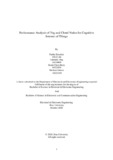Performance analysis of Fog and Cloud Nodes for Cognitive Internet of Things
Abstract
Over the past decade, human interest in wireless communication has increased remarkably, and
this has led to the development of the Internet of Things (IoT), Cloud, Fog, and Edge
Computing. Existing wireless network models face several problems: low mobility, shortage
of storage space, and slow data transfer speed due to the increased data traffic. As 127 new IoT
devices are connected to the web every second, finding the solution to these problems has
become a necessity. To improve the baud rate, Cognitive Radio was introduced, allowing the
signals to select the shortest possible route during transmission. This paper proposes a model
for CIoT-Fog-Cloud networking and the Reconfigurable Intelligent Surface (RIS) framework
to resolve some of the problems. Fog-Cloud computation and Fog-Fog computation are the two
situations considered to explain that storage computation would be more efficient, owning to a
reduced physical distance between the Fog Nodes. The simulation results provided signs of
quicker data transfer with low energy consumption and less transmission time

